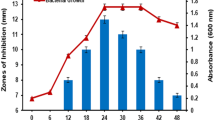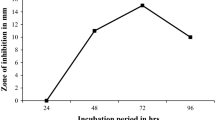Abstract
Microorganisms secrete antimicrobial peptides (AMPs) which are part of the innate immune system and rapidly increase in concentration in the host upon challenge by pathogens, which they produce themselves. Kimchi, a traditional Korean food fermented by Bacillus organisms, is found to be ideal for AMP production. Our aim was to investigate the therapeutic potential of antimicrobial substances produced by Bacillus species. Peptide K1R was subjected to fermentation in a culture media containing carbon and nitrogen sources and metal ions. A protein band around 4.6 kDa was detected in tricine-SDS-PAGE and confirmed by in situ inhibitory activity of the gel. Peptide K1R was stable over a broad range of pH (6.5–9), thermo tolerant up to 60 °C and showed unaltered activity at low temperatures (0–4 °C). The complete amino acid sequence of peptide K1R was AVQGTLEDALNLSKGALNQVQKAIQNGDXLTVXGXLGTIXLAVSX. The antagonistic effect of peptide K1R against multiple drug resistant (MDR) pathogens such as Salmonella Typhimurium and Enterococcus sp. verified its potential application in treating MDR cases. The antioxidant activity of peptide K1R was also comparable to that of standard ascorbic acid.








Similar content being viewed by others
References
Alkotaini B, Anuar N, Kadhum AAH (2013) The effects of temperature, pH and carbon sources on antimicrobial peptide AN5-1 production using Paenibacillus alvei AN 5. Asian J Microbiol Biotechnol Environ Sci 15(1):195–201
Andreu D, Rivas L (1998) Animal antimicrobial peptides: an overview. Pept Sci 47(6):415–433
Biswas SR, Ray P, Johnson MC, Ray B (1991) Influence of growth conditions on the production of a bacteriocin, pediocin AcH, by Pediococcus acidilactici H. Appl Environ Microbiol 57(4):1265–1267
Bizani D, Brandelli A (2002) Characterization of a bacteriocin produced by a newly isolated Bacillus sp. Strain 8 A. J Appl Microbiol 93(3):512–519
Bollag Daniel M, Rozycki Michael D, E. SJ (1996). Protein Methods. The Quarterly Review of Biology 72, no.2.
Borquaye LS, Darko G, Ocansey E, Ankomah E (2015) Antimicrobial and antioxidant properties of the crude peptide extracts of Galatea paradoxa and Patella rustica. SpringerPlus 4(1):1
Bowdish, DME, Davidson DJ, Lau YE, Lee K, Scott MG, Hancock, R. E. W. (2005) Impact of LL-37 on anti-infective immunity. J Leukocyte Biol 77(4):451–459
Bradford, MM (1976). A rapid and sensitive method for the quantitation of microgram quantities of protein utilizing the principle of protein–dye binding. Anal Biochem 72, 248–254
Brogden KA (2005) Antimicrobial peptides: pore formers or metabolic inhibitors in bacteria? Nat Rev Microbiol 3(3):238–250
Brown KL, Hancock, REW (2006) Cationic host defense (antimicrobial) peptides. Curr Opin Immunol 18(1):24–30
Cheigh CI, Choi HJ, Park H, Kim SB, Kook MC, Kim TS, Pyun YR (2002) Influence of growth conditions on the production of a nisin-like bacteriocin by Lactococcus lactis subsp. lactis A164 isolated from kimchi. J Biotechnol 95(3):225–235
Choi YH, Cho SS, Simkhada JR, Yoo JC (2012) A novel thermotolerant and acidotolerant peptide produced by a Bacillus strain newly isolated from a fermented food (kimchi) shows activity against multidrug-resistant bacteria. Int J Antimicrob Agents 40(1):80–83
Elsbach P (2003) What is the real role of antimicrobial polypeptides that can mediate several other inflammatory responses? J Clin Investig 111(11):1643–1645
Falagas ME, Fragoulis KN, Karydis I (2006) A comparative study on the cost of new antibiotics and drugs of other therapeutic categories. PLoS ONE 1(1):e11
Gasteiger E, Hoogland C, Gattiker A, Duvaud S, Wilkins MR, Appel RD, A. B. (2005). Protein identification and analysis tools on the ExPASy server. In: John M. Walker (ed), The Proteomics Protocols Handbook, Humana Press Inc., Newyork pp. 571-607
Jack RW, Tagg JR, Ray B (1995) Bacteriocins of gram-positive bacteria. Microbiol Rev 59(2):171–200
Jenssen H, Hamill P, Hancock, R. E. W. (2006). Peptide antimicrobial agents. Clin Microbiol Rev 19 (3):491-511
Joerger RD (2003) Alternatives to antibiotics: bacteriocins, antimicrobial peptides and bacteriophages. Poult Sci 82(4):640–647
Jorgensen JH, Ferraro MJ (2009) Antimicrobial susceptibility testing: a review of general principles and contemporary practices. Clin Infect Dis 49(11):1749–1755
Kamoun F, Mejdoub H, Aouissaoui H, Reinbolt J, Hammami A, Jaoua S (2005) Purification, amino acid sequence and characterization of Bacthuricin F4, a new bacteriocin produced by Bacillus thuringiensis. J Appl Microbiol 98(4):881–888
Kim EK, An SY, Lee MS, Kim TH, Lee HK, Hwang WS, Lee KW (2011) Fermented kimchi reduces body weight and improves metabolic parameters in overweight and obese patients. Nutr Res 31(6):436–443
Klaenhammer TR (1993) Genetics of bacteriocins produced by lactic acid bacteria. FEMS Microbiol Rev 12(1–3):39–85
Kong C-S, Bahn Y-E, Kim B-K, Lee K-Y, Park K-Y (2010) Antiproliferative effect of chitosan-added kimchi in HT-29 human colon carcinoma cells. J Med Food 13(1):6–12
Lee HJ, Joo YJ, Park CS, Kim SH, Hwang IK, Ahn JS, Mheen TI (1999) Purification and characterization of a bacteriocin produced by Lactococcus lactis subsp, lactis H-559 isolated from kimchi. J Biosci Bioeng 88(2):153–159
Lee H, Yoon H, Ji Y, Kim H, Park H, Lee J, Holzapfel W (2011) Functional properties of Lactobacillus strains isolated from kimchi. Int J Food Microbiol 145(1):155–161
Lejeune R, Callewaert R, Crabbé K, De Vuyst L (1998) Modelling the growth and bacteriocin production by Lactobacillus amylovorus DCE 471 in batch cultivation. J Appl Microbiol 84(2):159–168
Mukherjee S, Das P, Sen R (2006) Towards commercial production of microbial surfactants. TRENDS in Biotechnol 24(11):509–515
Noh JS, Choi YH, Song YO (2012). Beneficial effects of the active principle component of Korean cabbage kimchi via increasing nitric oxide production and suppressing inflammation in the aorta of apoE knockout mice. Br J Nutr 109 (01) 17–24
Parente E, Ricciardi A (1994) Influence of pH on the production of enterocin 1146 during batch fermentation. Lett Appl Microbiol 19(1):12–15
Regmi S, Choi YH, Choi YS, Kim MR, Yoo JC (2016). Antimicrobial peptide isolated from Bacillus amyloliquefaciens K14 revitalizes its use in combinatorial drug therapy. Folia Microbiol 1–12
Rodrigues L, Banat IM, Teixeira J, Oliveira R (2006) Biosurfactants: potential applications in medicine. J Antimicrob Chemother 57(4):609–618
Rosenfeld Y, Sahl H-G, Shai Y (2008) parameters involved in antimicrobial and endotoxin detoxification activities of antimicrobial peptides†. BioChemistry 47(24):6468–6478
Sang Y, Blecha F (2008) Antimicrobial peptides and bacteriocins: alternatives to traditional antibiotics. Anim Health Res Rev 9(2):227–235
Schägger H (2006) Tricine-SDS–PAGE. Nat Protoc 1(1):16–22
Selhub EM, Logan AC, Bested AC (2014) Fermented foods, microbiota, and mental health: ancient practice meets nutritional psychiatry. J Physiol Anthropol 33:2
Shin MS, Han SK, Ryu JS, Kim KS, Lee WK (2008) Isolation and partial characterization of a bacteriocin produced by Pediococcus pentosaceus K23-2 isolated from Kimchi. J Appl Microbiol 105(2):331–339
Tomás J, Bru E, Wiese B, de Ruiz Holgado, A. A. P., Nader-Macías ME (2002) Influence of pH, temperature and culture media on the growth and bacteriocin production by vaginal Lactobacillus salivarius CRL 1328. J Appl Microbiol 93(4):714–724
Wiegand I, Hilpert K, Hancock, R. E. W. (2008) Agar and broth dilution methods to determine the minimal inhibitory concentration (MIC) of antimicrobial substances. Nat Protoc 3(2):163–175
Yamanaka H, Moriyoshi K, Ohmoto T, Ohe T, Sakai K (2007) Degradation of bisphenol a by Bacillus pumilus isolated from kimchi, a traditionally fermented food. Appl Biochem Biotechnol 136(1):39–51
Yeaman MR, Yount NY (2003) Mechanisms of antimicrobial peptide action and resistance. Pharmacol Rev 55(1):27–55
Zhang X, Koo J, Eun J (2006) Antioxidant activities of methanol extracts and phenolic compounds in Asian pear at different stages of maturity. Food Sci Biotechnol 15(1):44
Acknowledgements
This work was supported by the National Research Foundationof Korea (NRF) grant funded by the Korean government (MEST) (NRF-2015R1A2A1A15056120, NRF-2015R1D1A1A 010 59 483) and “Cooperative Research Program for Agriculture Science & Technology Development (Project No. PJ01128901)” Rural Development Administration, Republic of Korea.
Author information
Authors and Affiliations
Corresponding authors
Additional information
Sandesh Panthi and Yun Hee Choi have contributed equally to this work.
Rights and permissions
About this article
Cite this article
Panthi, S., Choi, Y.H., Jee, JP. et al. Antimicrobial Peptide from Bacillus Strain K1R Exhibits Ameliorative Potential Against Vancomycin-Resistant Enterococcus Group of Organisms. Int J Pept Res Ther 23, 419–430 (2017). https://doi.org/10.1007/s10989-016-9572-2
Accepted:
Published:
Issue Date:
DOI: https://doi.org/10.1007/s10989-016-9572-2




